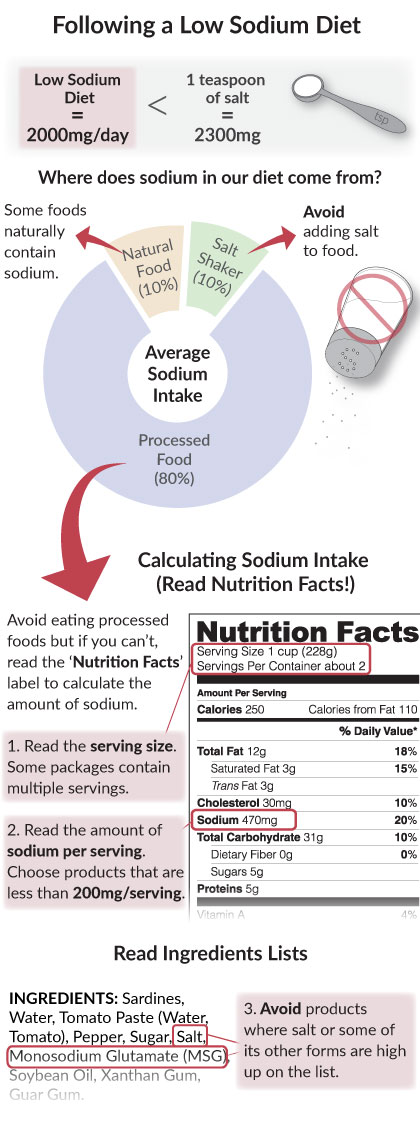If you have heart failure or high blood pressure, it is important to reduce the amount of sodium you eat. Sodium causes extra fluid to build up in your body. This extra fluid makes your heart work harder and leads to fluid building up in your legs and ankles, as well as in your lungs, making it difficult to breathe.
What is Sodium?
Sodium is a mineral found in salt. One teaspoon of salt equals approximately 2300 mg of sodium. Two-thirds of the salt in the Canadian diet is hidden in food.
What is a low sodium diet?
It is best to limit the amount of sodium you eat to 2000 mg or less per day from all food sources. This will help prevent the accumulation of extra fluid in the body.
Reading Nutritional Labels
Approximately 10% of the salt in our diet comes from sodium found naturally in foods, 10% from what is added by using the salt shaker, and 80% from when food is processed. Food manufacturers may change ingredients over time. That is why it is important to make it a habit to read the nutritional label. Reading nutritional labels is key to determine the sodium content of foods. The amount of sodium in food is listed on the package. It is important to learn how to read the Nutrition Facts panel.
What are the Steps to Reading Food Labels?

-
Serving Size:
Compare the suggested serving size on the package to the amount that you actually eat – this can sometimes be very different. The label lists the amount of sodium in one serving and not the total amount of sodium in the entire package.
-
Sodium:
Look at the amount of sodium in mg per serving. Try to choose products with less than 200 mg per serving or 10% or less of the Daily Value per serving.
-
Ingredients:
Ingredients are listed in decreasing order by amount. If an ingredient appears earlier in the list, that means there is more of it in the package. So make sure that if salt or sodium appears, that it is near the end of the list. Sometimes the salt can be hidden, look out for these ingredients: sodium, monosodium glutamate (MSG), brine, sodium nitrite, sodium propionate, baking soda, and baking powder.
Tips to Reduce Sodium in Your Diet
- Avoid using salt in your cooking and remove the salt shaker from your table.
- Buy fresh fruits and vegetables and prepare your meals at home.
- Avoid salted snack foods, such as chips, crackers and nuts.
- Choose foods labeled “low sodium” or “no salt added“.
- Read food labels to see how much sodium is in that food.
- Avoid “processed foods”:
- Canned or packaged soups
- Instant foods like oatmeal or puddings
- Processed cheese slices or spreads
- Processed, cured or smoked meats like sausages, wieners, ham, bacon, or smoked fish
- Canned vegetables, meats and fish
- Canned tomato and vegetable juices
- Frozen dinners and entrees
Tips for Meal Planning
- Reduce your salt gradually to give your taste buds time to adjust.
- When grocery shopping, choose items from the outer aisles where most of the fresh products are found.
- Plan your meals ahead of time.
- Grill an extra chicken breast to use for a sandwich the next day.
- Season foods with lemon juice, vinegar, fresh garlic, herbs and spices.
- Don’t use spices that contain salt or sodium, like garlic salt or onion salt
- Avoid using salt substitutes like No Salt® and Half Salt®
- You may choose seasoning blends such as “Mrs. Dash” or President’s Choice “No salt added seasoning blend“
- Make salad dressing with fresh garlic, olive oil and flavoured vinegar.
- Search online for low sodium recipes.
- Try a new low sodium cookbook.
- A helpful resource is the Canadian Food Guide website.
What to do when dining out?
- Choose restaurants that:
- offer as much variety on their menu as possible
- are willing to prepare food for special request
- Request that foods be prepared without added salt.
- If you are unsure of ingredients, ask how foods are prepared.
- Do not use the salt shaker.
- Request that foods be served without the condiments that are high in salt (relish, mustard, ketchup, pickles, sauces, etc.). Ask for lower salt substitutions such as sliced tomatoes/cucumbers/lettuce, oil and vinegar, and lemon.
- Eat foods in their fresh state. Try grilled vegetables or fish rather than deep fried or battered fish.
- Remember that soups, JELL-O, ice-cream, as well as beverages must be included as part of your daily fluid allowance.
- If you are travelling, plan stops where lower sodium foods may be obtained or plan a picnic which includes fruits, vegetables and sandwiches.
Take Home Messages
- If you have heart failure, one of the most important things you can do to avoid retaining extra fluid is to reduce the amount of sodium (salt) in your diet.
- The first step is to remove the saltshaker from your table. You should not add any extra salt to your food.
- Most processed food contains a lot of sodium. An important skill is learning how to read food labels.